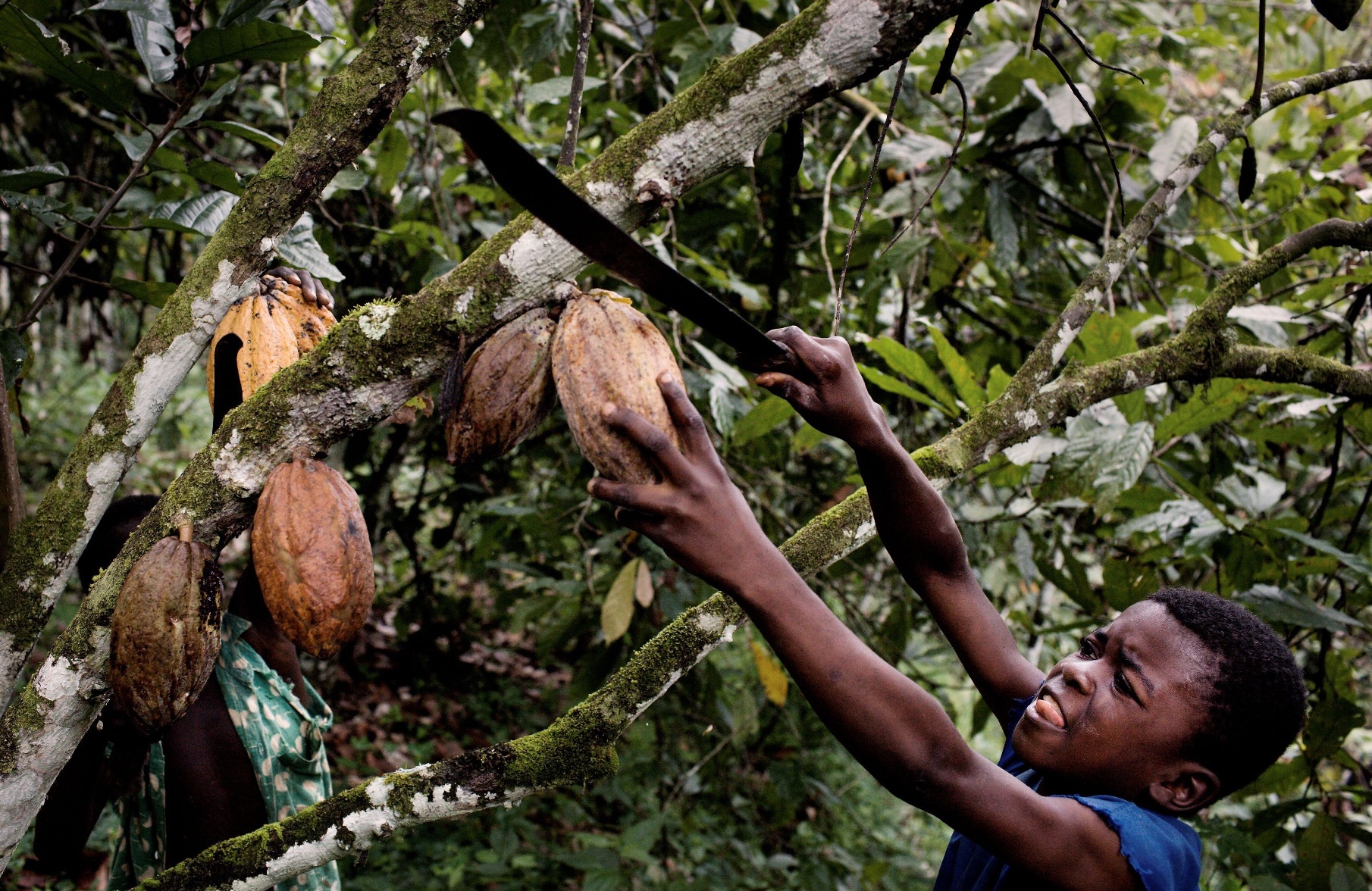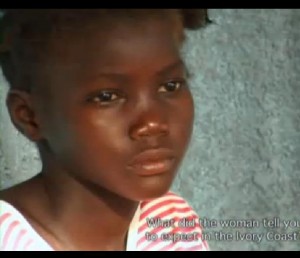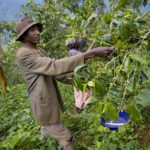Chocolate often originates from the hands of children working as slaves. In Côte D’Ivoire and other cocoa-producing countries, an estimated 100,000 children labor in the fields, many against their will. Action taken now demands that Hershey “Raise the Bar” on their fair trade labor practices, which led to them declaring that they will buy only from certified sources by 2020.


The Human Cost of Chocolate
Hershey, the USA’s largest and most iconic chocolate company, sources much of its cocoa from West Africa, where 70 percent of the world’s cocoa comes from and where child labor is epidemic. They have agreed to buying 100 percent of their cocoa from certified sources by 2020.
Currently, less than five percent of the world’s cocoa supply is from certified sources.
We look at a Danish documentary on the subject as well as a CNN Report and finally the “Time to Raise the Bar, Hershey” Report by Global Exchange, GreenAmerica and the International Labor Rights Forum.
httpvh://youtu.be/ZNpwIzeyjKQ
“The Dark Side of Chocolate,” Directed by award winning Danish journalist Miki Mistrati and U. Roberto Romano
The 2001 Cocoa Protocol
Ten years ago, U.S. Rep. Eliot Engel, D-New York, and Sen. Tom Harkin, D-Iowa, introduced legislation mandating a labeling system for chocolate. After the industry raised concerns, a compromise was reached that required chocolate companies to voluntarily certify they had stopped the practice of child labor. The certification process would not involve labeling products “child-labor-free,” as initially proposed.
Instead, it calls for public reporting by African governments, establishment of an audit system and poverty remediation by 2005. The deadline had to be extended to 2008 (read Fortune Magazine’s report on the state of the protocol in 2008) and again to 2010. Today, many aid groups say some of the provisions have still not been met.
Ending Child Labor in the Cocoa Industry
Some 70 to 75 percent of the world’s cocoa beans are grown on small farms in West Africa, including the Ivory Coast, Ghana, Cameroon, and Nigeria, according to the World Cocoa Foundation and the International Cocoa Initiative. Despite implementation of the Cocoa Protocol, the U.S. State Department estimates more than 100,000 children are involved in the worst forms of child labor on cocoa farms throughout the Ivory Coast and Ghana. Some are the children of cocoa farmers but many are smuggled into Ivory Coast from Mali and Burkina Faso to work on cocoa plantations, according to the International Labor Rights Forum.
Italian chocolate maker Ferrero has also pledged to eradicate slavery from farms where it sources its cocoa by 2020, as part of a growing movement by the multi-billion dollar industry to clean up its supply chains.
Limitations of the Cocoa Protocol. Voluntary certification has not been proven to stop abuses labor practices. In addition, Ivory Coast has had further economic problems following its civil war from 2002 to 2004. Chocolate exporters and manufacturers say the war and its aftermath have hampered their efforts to eradicate child labor. Nevertheless, a reputable, independent, third party certification can ensure that a process is in place to identify and remediate labor rights abuses. For cocoa, the strongest certification system currently available is fair trade.
“Honestly, it’s hard to see anybody saying that this protocol has attained the goals that were set out in it,” said Judy Gearhart, executive director of the International Labor Rights Forum in the CNN report. Chris Bayer, a Tulane University researcher, spent five years in the Ivory Coast and Ghana monitoring the protocol’s plan and studying the scope of the problem. “Unfortunately, over the last 10 years we have seen very little implementation of the actual commitments,” he said. “Industry did not live up to the Harkin-Engel protocol. The issues are systemic. Children are still working.”
The International Cocoa Initiative was set up by the protocol to bring all parties together to address the worst forms of child labor in the supply chain. The ICI board has representatives from the major cocoa processors and chocolate manufacturers. It says progress is being made.
“Five of the six commitments made in the protocol have been completed,” the group said in an e-mail statement. “And governments of cocoa producing countries, ILO, the OECD, independent foundations, members of the cocoa supply chain and ICI itself are ACTIVELY working on the sixth commitment – to improve the livelihoods of cocoa growers the infrastructure in cocoa communities farmers organizations, educational facilities etc. Substantial funds are being expended on these activities.”
Clearly, more work needs to be done on the issue.
Raise the Bar, Hershey
The release of Time to Raise the Bar: The Real Corporate Social Responsibility Report for the Hershey Company on September 13th, 2010 highlighted Hershey’s failure to address instances of child labor in its supply chain. Ten years after the problem of exploitive child labor on West African cocoa farms was brought to the attention of the public in the United States and chocolate companies pledged to eliminate these abuses, Hershey has not done enough to stop child labor.
One problem with Hershey’s announcement: the company did not specify what type of certification it will obtain for the cocoa. Instead, they stated the certified cocoa will be “be verified through independent auditors to assure that it is grown in line with the highest internationally recognized standards for labor, environmental and better farming practices.” If Hershey’s is serious about stopping child labor on cocoa farms in West Africa, then the certification it seeks for its products will be fair trade.
The coalition of organizations that released the report called on Hershey to:
- Take immediate action to eliminate forced and child labor from its supply chain;
- Commit to sourcing 100% fair trade certified cocoa beans by 2012 for at least one of its five top-selling chocolate bars;
- Commit to making at least one additional five top-selling bar 100% fair trade certified every two years thereafter, so that Hershey’s five top-selling cocoa bars will all be 100% fair trade certified within ten years;
- Commit that the majority of Hershey’s cocoa across all products will be fair trade certified by 2022.
In March 2011, a research team from the Payson Center for International Development at Tulane University, under a contract from the US Department of Labor (DOL), issued a report stating that one of the most effective ways to eliminate forced and child labor in cocoa production is through the use of product certified cocoa, like fair trade. Committing to fair trade certified cocoa would enable Hershey to ensure its suppliers undergo a rigorous review by independent monitors, who check for cases of forced and/or child labor and ensure producers earn a decent price for their cocoa.
Several large food corporations, including many of Hershey’s closest competitors, made significant commitments to fair trade and other certification systems in the past decade and are taking steps to eliminate child labor from their supply chains.
Abuses in the US by Hershey
Democracy Now! recently reported on the case of 300 foreign students in the United States as part of a work-study program and found themselves engaged in what they refer to as captive labor at a Hershey’s packing plant in Palmyra, Pennsylvania.
The students — from Eastern Europe and Asia — went on strike in August of 2011, after reportedly required to lift heavy boxes, work eight-hour shifts beginning at 11 p.m., and stand for long periods of time while packing candy on a fast-moving production line. Federal agencies have launched four investigations into the alleged exploitation.
The walkout apparently marks the first time that foreign students have engaged in a strike to protest their employment. The guest workers are demanding a return of the $3,000 to $6,000 each student paid for the cultural exchange program to work at Hershey, that Hershey end exploitation of J-1 student cultural exchange workers, and that the 400 jobs the guest workers filled instead be given to local workers paid a living wage.
Adapted From the CNN Freedom Project and Raise the Bar, Hershey














a very sad and heartbreaking documentary…i cant believe parents would do such monstery acts to their children,,,very very sad.
Pingback: The Lucrative and Violent Curse of Coltan Mining in Congo | WilderUtopia.com
Pingback: Dominican Republic: Modern Day Sugarcane Slavery | WilderUtopia.com
Pingback: Why is child labor happening and what can be done to stop it? – Africa: Past to Present (2019)